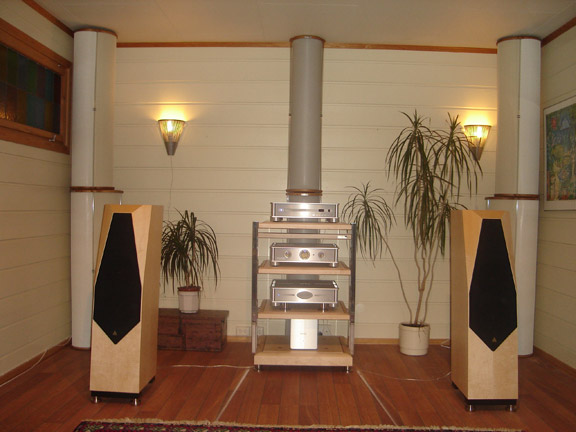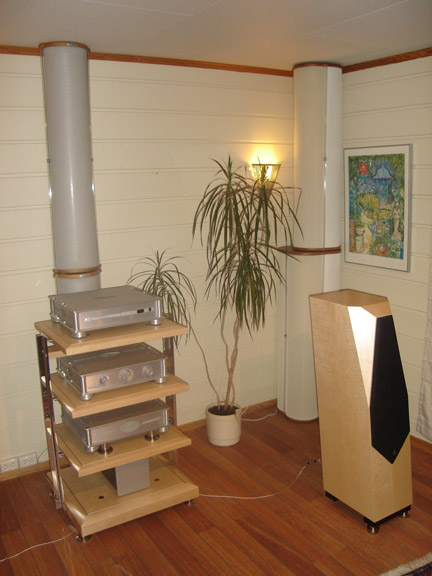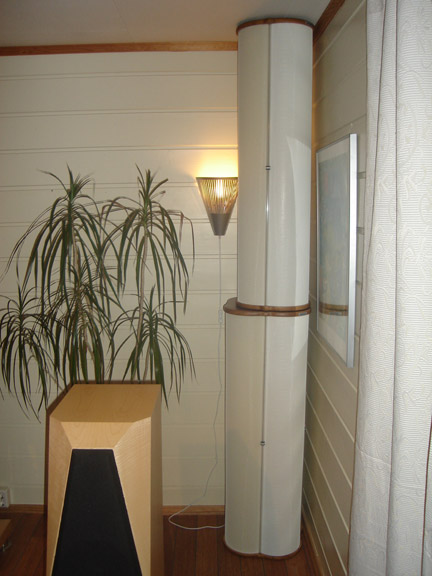DAAD (Diffusion Absorption Acoustic Devices)
| DAAD (Diffusion Absorption Acoustic Devices) |
| Building “Acropolis” at home and how I learnt a lesson |
|
|
|
April 2007 |

Like most audiophiles who’ve been in this hobby for many years, I too, have tried a lot of equipment. From vintage tube gear from Dynaco and C-J to solid-state electronics from NAD, Tandberg, Krell, Nakamichi, EC, etc. I have owned large speakers from Infinity, small Dynaudio`s, Proac`s, different Peak-Consults etc. I have also changed more cables than I am willing to admit, believe me.
All these years my focus has been on the equipment and investing money where I thought it made the largest impact on the sound. What I have learned is that the sound changes every time I swap gear, but that change wasn’t always better. But of course, my system at present communicates the music on a high level and before my journey into the mysteries of acoustic room treatment began I was very pleased with the sound.
After redecorating my house and my listening room this winter, I thought that it was time to “get the job done” and make the last investments into the system. Therefore, I started to read about room acoustics on the internet and in magazines. Previously I have taken, as I am sure that many others have, shortcuts as far as room acoustics are concerned. Carpets, drapes, pillows, plants etc. I’m not saying that such devices can’t do anything for the sound. They may help, but nothing can replace good theory and well crafted products. I can say this now because I know. There are no cheap ways to get really good sound at home in general and room acoustics are no exception to that rule.
This review could only happen because the Norwegian importer Base-Technology made a lot of efforts. That said, I have to confess that this was a difficult review to write. One reason was that the sound changed every time I made any adjustments. Not much, but enough so that I had to concentrate and play the same cuts over and over again to verify my findings.
One other issue here was the theory behind the products, most of them new to me. Yes I have heard about echoes, standing waves etc., but never really bothered to investigate them further. I feel like a fool now for not having taken the time to learn more about acoustics earlier. Well, it’s never too late.
When I contacted the importer the first time, he asked me for a drawing of my listening room. This is standard procedure at Acoustica Applicata, and what I got back from them really told me that they are serious about what they are doing. I got three drawings, all from different angles with placement recommendations and indications of the reflective patterns from the speakers. Let me say this at once; what they recommended proved to be very close to the perfect placement in my room. Even the angle on where to point the reflective and absorbing (it is marked on the DAAD`s) sides were right. Not bad when all this was based upon my primitive drawing. So, trust these people, you are in good hands.
The DAADs (Diffusion Absorption Acoustic Devices) have a wooden plate on the top and bottom and their fit-n-finish is very good. They come in three different colors (white, grey, and black) and sizes:
The DAAD 2™ is for resonances at 120Hz and over, and for early lateral and back reflections.
The DAAD3™ is for resonances at 70Hz and over, and for all kinds of early reflections.
Finally, the DAAD4™ is for resonances at 50Hz and over, and for early anterior reflections.
On their website I found a very enjoyable article about how these Italian enthusiasts created the DAAD products. The following text is taken directly from this article. I mean, who could better describe their theory and products than themselves?
“In order to get what we wanted, we had to experiment with other materials and thicknesses that allowed air to penetrate the trap quickly and get out again after a given time. These new materials shouldn’t create excessive friction to the air passing through them, in order not to slow down the functioning of the entire acoustic device with regard to the timing of music transients that follow each other. What we wanted was a ‘fast’ trap!
After some substantial additional research we finally found a satisfactory combination of two materials. At that point (we were in 1998), we had found two important ingredients: the micro-pressed reticulate for the cover grille and an interesting combination of materials for the resistive layer inside. Apart from being extremely interesting from an acoustic point of view, these two materials offered other important practical advantages. The micro-pressed metal sheet looks better and is easier to clean than the cloth covering Tube Traps. The new resistive material inside doesn’t dust and, therefore, doesn’t need to be wrapped in a protective mantle like glass wool in Tube Traps. So all we had to do now was to define the final shape of our new acoustic device.
The shape of a lobe seemed the most suitable one, for the following reasons:
“The shape of a lobe seemed the most suitable one, for the following reasons:
1. its internal volume being equal to a cylinder, a lobe-shaped device ‘penetrates’ the corners of a room more deeply, thus capturing the resounding frequencies more easily;
2. its shape facilitates the simultaneous use of different materials for the resistive layer of the device;
3. like a cylinder, but unlike a flat panel, a lobe device allows one to have an inner volume with air and a thickness able to create ‘acoustic shade’. In other words, it provides a very good ratio between the space used and the results that are reached;
4. like a cylinder, but unlike a flat panel, a lobe device can be rotated on itself. Having lobes with different diffusion characteristics allow one to position them in several ways and to change room acoustics according to one’s personal needs or tastes”.
All we had to do now was to find the right ratio between the thickness of the resistive material and the degree of ‘permeability’ to air of the pressed metal sheet. Listening tests and further changes to our prototypes followed each other at a very fast pace. We focused mainly on some specific issues: the quality of the reproduced voice, which had to be open and clear, without halos (and here the rendering of vowels was particularly important); the sensation of air, freedom, the opening of the soundstage; the lack of boomy low frequencies and of muddy sound in the heat zone (100-300 Hz)”.
If you are interested you can read the whole article here:
Building Acropolis at home

I have a dedicated listening room and can really do what I want in it. And that’s a good thing because setting up a lot of DAAD`s in a room certainly makes a visual impact. That said, they blended very well into the room, though I still wasn’t sure if I really want to have this kind of product in my living room. Well, let me be honest with you: My wife would not allow it either!
My room is about 5.5 meters long and 4.5 meters wide. The ceiling is 2.3 high. I have a massive wooden floor with a large oriental carpet in front of the system. The walls are made of wood and the only furniture I have is my listening chair, a CD rack and some low bookshelves. I have some plants behind the speakers, for decoration purposes.
The ideal listening room needs a touch of reverb to prevent the room sounding unnaturally dead. I know. I have experienced this once with an overdose of acoustic treatment in combination with heavy wall-to-wall carpet. The sound was absolutely lifeless. So keep in mind that all things acoustical must be done with some help from experts. By all means, try it for yourself, but do not expect a miracle.
 The importer brought eight DAADs to my house. We followed the instructions given to us by the manufacturer and the result was visually somewhat “Acropolistic.” In the corners, behind the speakers, one DAAD 3 was stacked on top of a DAAD 4 and reached from the floor to the ceiling. On both sides of the rack we placed one DAAD 2 and two DAAD 2s directly behind the rack, again from the floor to the ceiling. Remember that this is by no means a full treatment. For that you need also to treat the sides of the room and of course the area behind the listening position. With a full treatment my guess is that the results are even better than what I got in my room during the review period. I will try to do a follow up later. But if you can afford (and can live with) the full package, go ahead!
The importer brought eight DAADs to my house. We followed the instructions given to us by the manufacturer and the result was visually somewhat “Acropolistic.” In the corners, behind the speakers, one DAAD 3 was stacked on top of a DAAD 4 and reached from the floor to the ceiling. On both sides of the rack we placed one DAAD 2 and two DAAD 2s directly behind the rack, again from the floor to the ceiling. Remember that this is by no means a full treatment. For that you need also to treat the sides of the room and of course the area behind the listening position. With a full treatment my guess is that the results are even better than what I got in my room during the review period. I will try to do a follow up later. But if you can afford (and can live with) the full package, go ahead!
The lesson
The first thing I noticed when we finished the set up and fine tuning was that human voices sounded much more natural and soft. This was clear right from the outset when I talked to the importer who helped me with the installation. Being unaware of my acoustical problems this was a real surprise. I thought that my room was ok (but by no means perfect) because the room is rectangular, has some angels, a big carpet on the floor, plants and so on. Well, I was wrong and somewhat naive. Echoes, bass issues, standing waves and a somewhat uneven balance proved to be areas where the biggest challenges were.
When I started playing music, it was amazing how the soundstage got wider and deeper, the highs became more extended and natural, and bass became fuller and better defined. Much better that is. With the DAADs in place the bass had terrific extension; it was tighter and more controlled throughout the entire bass range and as transparent, articulate and quick as I’ve ever heard in my room.
The midrange was more natural and transparent than ever before. Not too much, not too little, just right. Everything was delivered with a particular neutrality and ease. Voices, speaking and singing, were also improved. Some female voice can be very intense. With the DAADs installed voices were still very present, but better sounding without any ruff edges. The sound of a piano when played hard and loud was much better because of the improved room acoustics. All in all, everything sounded more convincing than before. And that is what we aim for right? The amazing thing was that I got improved sound in all parts of the frequency range.
As I said in the beginning of this story the advice given by the manufacturer was spot on. I tried to turn the DAADs just a few degrees left or right, lift them up from the floor and tried different locations. I always ended up like I started.
With all the DAADs I had on hand in the room the improvement in the sound was very easy to hear with all kinds of music, no need to bother you with any more “audiophile jargons”, you know them too well. So, I realized that I had to buy some myself but I did not want the full package. The next project was to find the smallest amount of DAADs to get a significant improvement in the sound without having to fill up the room. And to drain my bank account completely. It has suffered enough over the last few years.
 Therefore, app. 2 weeks into the review period I started to experiment with placements and the reduction of DAADs. The question was this: Do you have to buy the full package or can improvements in room acoustics also be had by a smaller number of columns? The answer is fortunately; yes, you can. To try to see what was possible for a smaller investment I removed 2 of the DAAD 3 I had on top of the no. 4 in the corners behind the speakers. Then I removed one of the DAAD 2 I had behind my rack and both DAAD 2 that stood against the back wall.
Therefore, app. 2 weeks into the review period I started to experiment with placements and the reduction of DAADs. The question was this: Do you have to buy the full package or can improvements in room acoustics also be had by a smaller number of columns? The answer is fortunately; yes, you can. To try to see what was possible for a smaller investment I removed 2 of the DAAD 3 I had on top of the no. 4 in the corners behind the speakers. Then I removed one of the DAAD 2 I had behind my rack and both DAAD 2 that stood against the back wall.
Now I had (and still have!) the following: One DAAD 3 in each corner behind the speakers, one DAAD 2 directly behind the rack and one DAAD 2 on the left wall to deal with early reflections. On the right side of the system I have large drapes so the DAAD 2 on the left side helps to balance the sound and stabilize the soundstage.
I came to this set up after I had carried DAADs in and out of the listening room for hours playing the same 3 pieces of music. Interesting it may have been, but boy was I happy when I finally came to the end result. With this “light” set up I got about 80 % of the performance for 50 % of the price. I got improvements all over, but of course to a somewhat lesser degree. It is with audio as it is in life, you have to compromise. I found a solution that works fine in my room at present, maybe I will take it to the next level later on.
This experience tells me that it is important to have an open mind about all things in audio. Never take it for granted that you have got the most out of your system before you (within your limits) have tried different options. Every audiophile that invests time and money into a system MUST treat the room properly, it is that simple.
“Every listening room should have some”.
The DAADs are great tools for the fine tuning of a system. Much unlike what happens when you change electronics these products really make the sound better, not just different. Be humble enough to let the experts (in this case from Acoustica Applicta) help you make your system sound better. I feel I have squeezed out what I can from my system as it is now, and that is a good feeling. These products are highly addictive. Consider yourself warned!
Jan Petter Egidius
__________________
Manufacturer info:
Acustica Applicata
Via Roma, 79 – 55027
Gallicano (LUCCA -ITALY)
Tel. +39 0583 730322
Fax +39 0583 730914
E-mail info@acusticaapplicata.com
Website www.acusticaapplicata.com
Norwegian importer:
Nordic Sound Design
Norway
Website www.base-technology.com
![]()
Don’t forget to bookmark us! (CTRL-SHFT-D)
Stereo Times Masthead
Publisher/Founder
Clement Perry
Editor
Dave Thomas
Senior Editors
Frank Alles, Mike Girardi, Russell Lichter, Terry London, Moreno Mitchell, Paul Szabady, Bill Wells, Mike Wright, and Stephen Yan,
Current Contributors
David Abramson, Tim Barrall, Dave Allison, Ron Cook, Lewis Dardick, John Hoffman, Dan Secula, Don Shaulis, Greg Simmons, Eric Teh, Greg Voth, Richard Willie, Ed Van Winkle, Rob Dockery, Richard Doran, and Daveed Turek
Site Management Clement Perry
Ad Designer: Martin Perry





Be the first to comment on: DAAD (Diffusion Absorption Acoustic Devices)